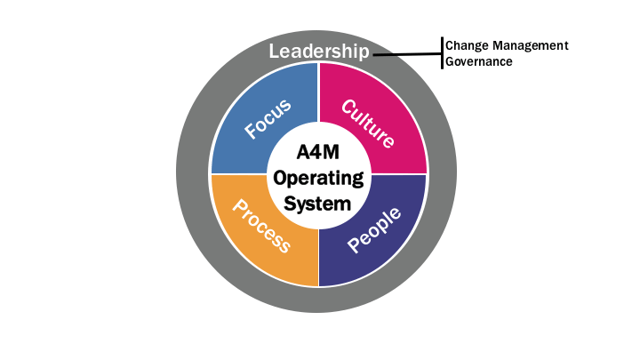Leadership: the Master Key to Success with Agile Marketing
Many agile practitioners use the phrase “people before process”. This is because using agile and having it succeed relies a great amount on the sincere participation of all players involved. For agile to take root and enable expected performance enhancements, the organization must change. In fact, the very culture must change. All team members have to embrace the new way of working. They have to get over the discomfort of change and be open to greater transparency and more accountability. They also must feel supported, secure, and empowered to embark on the journey.
In our experience, successful adoption of Agile for Marketing hinges on having the right leadership.
The fifth and final component of the Agile for Marketing Operating System™ is Leadership. Leadership is the driving force that brings all of the operating system components together. Adopting agile marketing takes patience and perseverance; it requires leadership that supports change and fosters self-organizing, accountable teams. It requires understanding what is working and not working and basing decisions on results. Leaders have to listen to their teams and help remove barriers as quickly as possible. Far from a one-off decision, becoming agile relies on consistent management through change and continuing governance over the operating system.
Leadership within the Marketing Operating system is simply two things:
- Managing change
- Governing the system

Managing Change
Resistance to change is entrenched in most organizations. People resist change because they fear the unknown, and they are comfortable with “the way we’ve always done it”. As a result, the majority of change efforts fail. The Agile for Marketing Operating System is designed to beat those odds by doing the following:
- Aligning stakeholders
- Prioritizing with a focus on measureable results
- Building an iterative process design (build-test-learn)
These three actions foster positive momentum, team empowerment, and more frequent opportunities to celebrate the “wins” (or to end underperforming tactics). Agile breaks old processes and quickly rebuilds to a new and more effective way of working.
The number one role for leaders within the new system is to manage this significant change. During the adoption of agile, management must be tuned in to where the obstacles are and work to remove them. Leaders must also ensure that there is clear, consistent direction provided to employees and teams. Effectively communicating shared priorities is key. Leaders need to manage the change by becoming a champion and advocate for the adoption of Agile. Without this focus, agile marketing will fail.
Governance
The second tenet of leadership is governance. This refers to the responsibility of leaders in the organization to govern and support the operating system. As we have shared the components of the operating system over the past five posts, topics like strategy, prioritization, and professional development have been presented as crucial elements. It is the job of the leaders to govern each of the following areas:
- Setting strategy – Provide clarity on strategy and prioritization at the organizational level to ensure the teams have clarity and focus on the right things
- Managing resources and processes – Manage the allocation of budget and resources to ensure teams are set up for success; develop success metrics and make process decisions based on in-market performance
- Managing performance - Ensure the agile teams, marketing and cross-functional departments (legal, sales, product) are tracking to shared goals and objectives
- Fostering professional development - Identify where individuals and agile teams need to grow in order to enable greater performance and feed into professional development plans
Agile marketing is an operating system made up of a mindset and a methodology. It is designed to impact organizational effectiveness so the role of leadership in the system is absolutely critical. Agile marketing leaders are primary change agents who should model the behaviors they expect of their teams. They must focus on creating a culture of agility (mindset) and develop business processes (methodology) to support agile marketing throughout their organization. With strong leadership as the foundation to building speed and enhanced performance, agile teams are more likely to gain all the benefits of the Agile for Marketing Operating System.
Continue reading our content series:
Part 1 of 6: An Introduction To Our Agile For Marketing Operating System
Part 2 of 6: Anchoring Your Agile For Marketing Efforts With Focus
Part 3 of 6: Agile Marketing Success Depends On The Right People
Part 4 of 6: Create An Agile Culture To Foster Change
Part 5 of 6: The Crucial Role of Process in Agile Marketing
